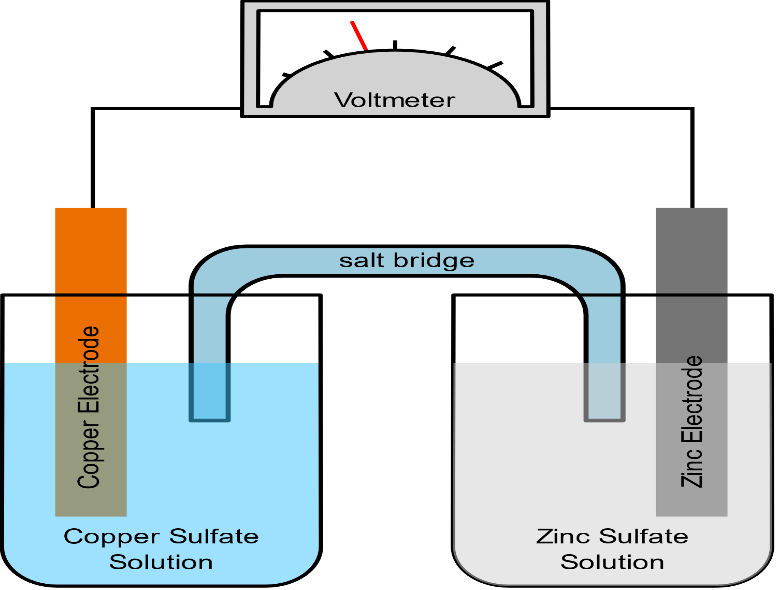
The function(s) of salt bridge in a cell is/are
A. It maintains standard electrode potential of cell constant which depends on several factors.
B. It completes the electrical circuit.
C. It departs both the solutions from each other.
D. It maintains the electrical neutrality of both electrolytic solutions.
Answer
219.3k+ views
Hint: A salt bridge is a chemical junction that connects the anodic and cathodic compartments in a cell or electrolytic solution thereby completing the circuit. It prevents the cell from taking its reaction to equilibrium and balances the charges in both the solutions.
Complete step-by-step answer:
A salt bridge is a device that is used in a galvanic cell for connecting its oxidation and reduction half cells where a weak electrolyte is used. It usually consists of a strong electrolyte which is further made up of ions such as KCl. These are generally used in a galvanic cell such as a voltaic cell or Daniel cell.

The main function of a salt bridge is to maintain the electrical neutrality of both electrolytic solutions within the internal circuit. It basically helps in preventing the accumulation of positive and negative charges around the respective electrolytic electrodes and further allowing a smooth reaction to occur. It also provides continual flow of electrons. However, the purpose of a salt bridge is not just to move electrons from the electrolyte rather to maintain charge balance because the electrons move from one-half cell to the other.
Salt bridge avoids the diffusion or mechanical flow of solution from one-half cell to another. It minimizes the liquid-liquid junction potential which arises between two solutions when they are in contact with each other. In short, it acts as an electrical contact between two half cells.
Hence, the correct options are (A), (B), (C) and (D).
Note: If there is no salt bridge in the cell, then the anodic and cathodic half cells will be joined only from one side and the electrical circuit will remain incomplete. There occurs a further accumulation of negative charge in one solution and positive in another.
Complete step-by-step answer:
A salt bridge is a device that is used in a galvanic cell for connecting its oxidation and reduction half cells where a weak electrolyte is used. It usually consists of a strong electrolyte which is further made up of ions such as KCl. These are generally used in a galvanic cell such as a voltaic cell or Daniel cell.

The main function of a salt bridge is to maintain the electrical neutrality of both electrolytic solutions within the internal circuit. It basically helps in preventing the accumulation of positive and negative charges around the respective electrolytic electrodes and further allowing a smooth reaction to occur. It also provides continual flow of electrons. However, the purpose of a salt bridge is not just to move electrons from the electrolyte rather to maintain charge balance because the electrons move from one-half cell to the other.
Salt bridge avoids the diffusion or mechanical flow of solution from one-half cell to another. It minimizes the liquid-liquid junction potential which arises between two solutions when they are in contact with each other. In short, it acts as an electrical contact between two half cells.
Hence, the correct options are (A), (B), (C) and (D).
Note: If there is no salt bridge in the cell, then the anodic and cathodic half cells will be joined only from one side and the electrical circuit will remain incomplete. There occurs a further accumulation of negative charge in one solution and positive in another.
Recently Updated Pages
The hybridization and shape of NH2 ion are a sp2 and class 11 chemistry JEE_Main

What is the pH of 001 M solution of HCl a 1 b 10 c class 11 chemistry JEE_Main

Aromatization of nhexane gives A Benzene B Toluene class 11 chemistry JEE_Main

Show how you will synthesise i 1Phenylethanol from class 11 chemistry JEE_Main

The enolic form of acetone contains a 10sigma bonds class 11 chemistry JEE_Main

Which of the following Compounds does not exhibit tautomerism class 11 chemistry JEE_Main

Trending doubts
JEE Main 2026: Application Form Open, Exam Dates, Syllabus, Eligibility & Question Papers

Derivation of Equation of Trajectory Explained for Students

Hybridisation in Chemistry – Concept, Types & Applications

Understanding the Angle of Deviation in a Prism

Understanding Collisions: Types and Examples for Students

Understanding Atomic Structure for Beginners

Other Pages
NCERT Solutions For Class 11 Chemistry Chapter 7 Redox Reaction

JEE Advanced Marks vs Ranks 2025: Understanding Category-wise Qualifying Marks and Previous Year Cut-offs

Thermodynamics Class 11 Chemistry Chapter 5 CBSE Notes - 2025-26

NCERT Solutions ForClass 11 Chemistry Chapter Chapter 5 Thermodynamics

Equilibrium Class 11 Chemistry Chapter 6 CBSE Notes - 2025-26

How to Convert a Galvanometer into an Ammeter or Voltmeter




